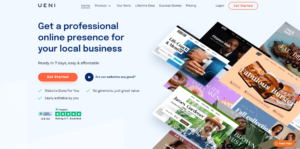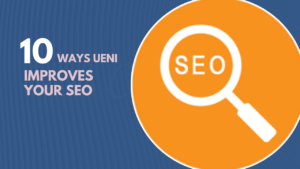Google has a legendary market share of the online search industry, amounting to a near-monopoly. The search engine behemoth processes 3.5 billion queries every single day, which translates into over 90% of global internet searches. Going on that number, at least 90% of your Search Engine Optimisation (SEO) strategy needs to be focused on figuring out how to rank higher on Google.
Here, then, are some straightforward strategies for small business owners to help you expand your reach and move up in search rankings.
If you’re a small business owner, this can suck up untold time and energy. With its vast scale, constantly evolving features and mysterious hidden corners, Google makes a daunting labyrinth for even the most experienced search marketers to navigate. There are hundreds of known (and still some unknown) factors determining where your page features in a given Google search. It can be hard to know where to start.
At UENI, we’re all about getting small businesses the exposure they deserve. As well as building free websites from scratch inside ten days, we also optimise websites for local Google search. This means we’ve spent a lot of time under the bonnet as it were, understanding how the search giant really works.
In this post, we’ll offer some straightforward starting points to help you get ahead of the competition and show you how to rank higher on Google. The first part of this article offers a primer on what you need to know about how Google search works:
- How to rank higher on Google or: what is SEO and why do I need it?
- All about algorithms: How does Google determine your search ranking?
In the second part of the post, we share five actionable strategies you need to use if you’re trying to improve your search visibility:
- Getting your site up to scratch
- Linking up with local search traffic
- Calibrating your keywords
- Producing quality on-page SEO content
- Learning to love the right kind of links
How to rank higher on Google or: what is SEO and why do I need it?
SEO (search engine optimisation) is all about improving how much traffic you draw to your website through search engines. You do this by improving the ranking of your website for given search phrases. The higher you are on the page, the more likely users are to click through to your website. By generating the right leads in this way, you’ll increase your sales.
The benefits of getting your business to the top of SERPs (search engine results pages) are enormous. Put simply, SEO is all about gaining competitive advantage. Search engine users rarely go beyond the first page of results, and a majority end up clicking one of the top 5 results. If you’re not at the top of the page, you’re missing out on traffic and ultimately, business.
There are additional benefits to good SEO practice: organic traffic growth, improved user experience and greater website trust. In short, consistent SEO will help your website (and your business) grow exponentially.
Let’s get a handle on the major factors affecting your Google search position.
All about algorithms: how does Google determine your search ranking?
Learning how to rank higher on Google starts with an understanding of how it prioritises websites and individual pages. The main thing you need to know about the Google search algorithm is that it’s constantly evolving. In 2018 alone, its team of experts made over 3000 changes to the way it ranks pages. Keeping abreast of these alterations is important but you can probably leave the finer details for the experts (and geeks like us) to debate.
If you’re starting out in SEO, there are some concrete features you can concentrate on in order to climb the rankings. Google’s own guiding principles are usability, relevance and usefulness. Here’s how the search engine measures those things.
Relevance
- Keywords: These are the foundation of your SEO strategy, signalling your page’s relevance to potential searchers. Finding the right keyword strategy is the key to SEO success. One dimension is keyword density: or rather, how often a term appears on your page. More important still is where that term appears. As well as measuring for frequency, Google will take it as a signal of higher relevance if it appears in your page headings or your meta description (the snippet that users see on the SERP). Likewise if the search term is in the first 100 words of your content.
- Click-through rate (CTR): This one’s more straightforward. If lots of people are choosing your page, it’s likely to be attracting that attention for a reason, right? That’s how the algorithm sees it in any case. You need to make sure people want to click on your website when they see it in a Google search. The key here is crafting an appealing meta description (the page description users see on the results page) and an enticing headline.
- Page age: Google prioritises fresh content, although regularly updated older pages can also perform well. This makes it important to keep up a regular stream of content as part of any SEO strategy.
- Social metrics: how often are people sharing the page on Facebook, Twitter, Instagram? All these shares are also creating links, so the profiles that they come from are as important as the volume. Google favours accounts with higher numbers of followers.
Usefulness
- Links: We’ll go into much more depth on these later but it’s all about a balance between quantity and quality. Google likes inward and outward-bound links which are connected to authoritative sites with high degrees of trust.
- Dwell time: how much time are people spending on your site after clicking through from a Google search? The algorithm favours sites which keep users within their domain for a long time. Content is the key here again. You need to build up a backlog of engaging and in-depth content that keep site users reading all the way to the bottom of the page.
- Content quality: Google says its number one priority is to link its users with content that provides the most user value. In 2019, quality is the gold standard of SEO and Google’s search algorithm has a number of inbuilt preferences when it comes to measuring this. We’ll revisit these more fully later.
Usability
- Bounce rate: your bounce rate is the percentage of users leaving your website after looking at just one page. There’s a bit of debate in the SEO community about this with Google stating it doesn’t explicitly rank based on this. However there’s a strong correlation between lower bounce rates and higher search rankings. Lowering your bounce rate might not directly increase your ranking, but the things you improve in the process probably will.
- Page loading speed: Google analyses how quickly content loads on a given webpage via HTML and Chrome.
- Mobile usability: you’ll be rewarded with a ranking boost for having a website that is optimised for mobile phone browsers.
- Site structure: is your coding perfect? Is your site layout user-friendly? How good is your server uptime? Technical factors like these are all things that Google analyses.
These are just some of the most obvious factors that influence where your website and pages will rank on a Google search. We’ll consider how to improve these features and many more in our simple guide on how to rank higher on Google. Here’s what we’ve learned to help you break down the challenge of competing for attention in the online space.
Getting your site up to scratch
Technical site-wide factors play a major part in where your web pages rank. As we’ve already noted, page loading speed matters when it comes to your Google ranking. It also has a major impact on your conversion rate. A couple of years ago, the BBC reported that most people will not wait more than three seconds for a shopping page to load.
There’s a direct correlation between how quickly your website loads and the volume of your online sales. You don’t want your customers bouncing off your site because of slow page speeds.
Getting your site up to scratch is not just about turbo-charging your website at the expense of quality content. It’s also about overall user experience (UX). You want the effortlessly quick and smooth ride of a sports saloon rather than the raw power of an F1 car.
In ten days or less, UENI can build you a custom-fit site that offers smooth and speedy browsing at zero cost to you. If this already sounds too good to be true, we also optimise your site using the methods discussed in this guide (and many many more besides) to improve your Google ranking and get you into pole position for local searches.
Check your current speed
You can use free tools like Pingdom and Google PageSpeed to check the speed of your site and find out how long pages are taking to load. Dealing with any slow-loading pages is your first priority. More generally, you should always look at new ways to improve your site speed as part of user experience. Concentrate on lowering your bounce rate and increasing your dwell time.
Optimise images
Use an image-editing programme to compress your pictures and save them as the appropriate file type for the task in hand. The end goal is user experience, so you have to think about speed and style. It’s about how it looks on the page as well as how the page performs. Bad visuals are almost as likely to put people off as bad loading speeds.
Striking a balance between page performance and the quality of your images is easy when you know how. For displaying larger photos, JPEG is probably your best option, offering you decent colour and clarity with good performance to boot. SVG offers you some useful functionalities for a logo: background transparency etc.
Remember to also use keywords on the file name and alt image tag when you upload images to your website.
Improve mobile user experience (UX)
As the processing capacity of mobile phones increases, so does the number of mobile phone searches. Google is constantly trying to reflect this in its search ranking, prioritising sites which perform well on mobile devices.
You can run Google’s Mobile-Friendly Test to see if your pages are adjudged as usable on mobile browsers. Follow this up with Google’s mobile site speed test, which will analyse the loading speed of an average page and give your site an overall rating for mobile functionality. It will also offer specific recommendations about how to improve your site for mobile users.
In the long run, some specific features you can implement to improve your mobile SEO are: mobile-friendly pop-ups, setting up AMP (accelerated mobile pages) and focusing on voice search queries.
Get an SSL certificate
Getting a security certificate for your website will give your users a secure connection on pages where they share personal information. If you’re processing online transactions, this is a must. As well as giving users piece of mind, getting a Secure Sockets Layer will also give you a ranking boost.
For most small businesses, an organisation validation SSL will do the job. There are various options out there (you get what you pay for) but prices start from as low as £25.
Implement browser caching
Every time a browser loads a webpage, it is downloading information in order to display words, image and whatnot. Browser caching stores information locally on the user’s computer so that it doesn’t have to be loaded from scratch when they navigate to the next page. This is an easy way of speeding up your site but does require some knowledge of coding.
Make your site easy for Google to read with a sitemap
A sitemap is an XML file which lists every webpage on your website, as well as its structure. The idea here is that you use this to point Google’s crawlers to the content you want them to see. In a game where small margins matter, having one of these will give you a small SEO boost. One free tool you can use to do this is XML-sitemaps.com.
With all these technical changes, it’s worth considering the option of professional help. This is especially true if you’re looking to upscale your business to the big time.
Linking up with local search traffic
If you’re a small brick and mortar operation, local search will be your main sales channel. Getting your business in front of local people using Google to search for a type of product or business has two distinct advantages over general organic search.
Firstly, it’s easier to climb the local rankings because there’s less high-profile competition. Secondly, you’ll be appealing to people who are close to the point of sale (both psychologically and geographically).
List in local directories
Your first step to ranking is to get listed on local business search directories like Yelp, Yell, Craigslist, Qype and Bing Places.
The listing process is straightforward enough in each instance. Create listings on each site and keep your business information complete, structured and up to date. Include your business name, your physical and email addresses, your phone number (with local dialling code). Make sure this information is all on your website as well and be consistent with formatting.
The challenge here is to make sure you’re listed everywhere people might reasonably search for your type of business. In the UK, there are upwards of 50 important sites to consider. In the US, the number is higher still. Outside of the Google search gamut, it’s also worth thinking about listing on vertical directories which are relevant to your location and/or niche. For instance, vegan restaurant app HappyCow could be a useful directory for restauranteurs looking to target plant-based eaters.
Set up shop with Google My Business
Any dissection of how to rank higher on Google local search would be incomplete if it didn’t mention Google My Business (GMB). For a comprehensive overview of how to leverage this vital small business tool, check out our full guide on Google My Business.
Having a verified GMB listing will give your business instant visibility and credibility, putting you right in front of buyers in the nearby area. Ranking in relevant local searches means Google Maps will literally direct people to your door.
Once your page is displayed in local search, you need to make sure you’re coming out on top of the competition. All the things we’ve already discussed are ranking factors here to some degree.
For local search, the easiest improvement you can make is to your GMB page. When you’ve gained access, you can verify and update business information (address, opening hours, phone number, email), showcase your shopfront with images and keep on top of user reviews.
Keep information consistent and comprehensive
Make sure your GMB page and your website have your business name, physical address, email, phone number (with local area code). These credentials are sometimes known as NAP. Consistently formatting this information will make your business more recognisable across the different directories.
An added bonus of local citations is that most directories have the option of including a link to your website. Put simply, these are also quality backlinks that will give your site some helpful link equity.
A final tip is to make sure that you incorporate your on-site business information as plain text, rather than as part of an image so that it’s readable for the Google crawlers analysing your website.
Get business reviews
Generating reviews will show your business is open and generating local interest. If you were opening a new café, you might consider offering free coffees in exchange for GMB user reviews to get started.
Engaging with customer compliments and complaints is one of your day-to-day duties as a small business owner. The good news is that doing this regularly on Google can give you a local search ranking boost.
Make sure your meta tags, titles and pictures give a clear idea of what you do
Potential customers should know what and where your business is from your meta tags, titles and images. Meta tags are the snippets you see when your business is displayed in local search and and your title is the clickable description above it.
If your shop is nearby and looks like it fits the bill, you might just make a quick sale. Good images of staff, products and the shop in operation will all give the impression of a reputable operation.
Embed Google Maps on your contact page
Having this on your contact page means people can click straight through to find directions to your exact location. This won’t give you an instant ranking boost but it’s another route for click-through to your GMB page and therefore, an avenue for more reviews.
Calibrating your keywords
Keywords are the foundation of all your SEO activity. They’re one of your most important tools for ranking higher and reaping the benefits. Devising a keyword strategy is all about pinpointing which queries are bringing traffic to your website and how you can generate new hits from related searches. As an overview, the process will look something like this:
- Assessing current search rankings
- Keyword research
- Finding long-tail keywords to target
- Distinguishing informational and commercial keywords
- Feeding keywords into content
Search marketing strategy
The first step is to find out where your site currently ranks on Google for specific terms. To do this, you’ll need to make use of online research tools. Semrush shows all the keywords a site currently ranks for and which of these are bringing you the most traffic. Just input your domain name and pick a country to find out where your website is coming out in specific searches.
What’s the aim here? To identify target terms (keywords) that you can climb the rankings for. Moving from page 2 to page 1 of a Google search might mean a modest increase in site visitors. The serious growth will come when you’re able to propel your site into the top five results for a given search. Here’s how you go about that.
Keyword research
There are plenty of options like SEMrush when it comes to understanding the words people use to find your site. Google’s Keyword Planner is another famous one. Keyword research tools like these can provide you data about your chosen keywords: monthly search volumes, competition, how much money other companies are spending on them.
Best of all, they can help you discover similar searches to target. If you were marketing a new vegan chocolate bar, you could input ‘vegan chocolate’. This would throw up related searches such as ‘where to buy vegan milk chocolate bar’ or ‘best vegan chocolate bar’.
Of course, accessing accurate Google keyword data will come at a price. If you’re trying to do SEO on a shoestring, there are some great free tools out there that do a similar job to Google’s Keyword Planner. Three starting options that will help you reach for low-hanging fruit are Answer the Public, Rank Tracker and Google Trends.
When you’re starting out in SEO, you should concentrate on targeting more specific searches. The best terms to focus on are those with low competition and decent search volumes. Catering to these more particular queries allows your site to build up reputation and trust, so that you can rank for the more popular searches in future.
Long-tail keywords
If you’re a small business, another pro tip is to focus on the more specific phrases that consumers use when they are close to the point of purchase. For example, ‘where to buy vegan milk chocolate bar’. These long-tail keywords target customers who already have a more specific idea of what they’re looking for.
More to the point, these searches are likely to be less competitive and easier to break into. Major brands spend vast sums of money to keep themselves ahead of the game and focus on very competitive keywords. It’s better to get 10 users a month than investing time and energy pursuing keywords monopolised by bigger businesses.
Above all, if you can show Google your website is capable of matching searcher intent by understanding long-tail keywords, this will help you to raise your website’s long-term reputation and make it easier to climb the rankings.
Informational and commercial keywords
When you’re researching keywords, it helps to think about user intention; in other words, why is that person using that term? Are they looking for general information or are they looking to buy? If you can match that intention, you’re increasing the usefulness of your website.
It’s all about working out where each search term places your prospective buyer in the sales funnel. In the above example, ‘vegan chocolate alternatives’ is a more general informational keyword. Someone who searches for this is probably looking to find out more about which products are on offer before buying.
A search like ‘where to buy vegan milk chocolate bars’ signals purchasing intent; the user already knows that this product exists and is looking to buy it. This is a commercial keyword. Words like ‘buy’, ‘purchase’, ‘deal’, ‘coupon’, ‘voucher’ often signal purchasing intent when used in tandem with a product name.
You need to think about both types of keyword when it comes to building your website and on-page SEO. Focusing on informational keywords will help you build trust and reputation in your brand. Commercial keywords are generally going to have better conversion rates, so they’ll help you bring home the bacon.
Producing quality on-page SEO content
Once you’ve understood the questions your customer base is asking (through keyword research) you can start providing them with useful answers. Sometimes the best answer can be the right product i.e. yours but you also need to convince your audience that you are a trustworthy name in your chosen area. This means devising a content strategy that targets commercial and informational keywords.
The simplest answer to the oft-asked question “how do I rank higher on Google?” is content, content, content. At its heart, Google seeks to link users up with the content that gives them the greatest value. In 2019, quality content is the gold standard of SEO.
Publish regularly
Creating content is perhaps the single most important method for improving your search rankings and increasing organic traffic. Use the keywords you’ve identified as good targets to brainstorm topics for a small content piece.
Create evergreen content with user value
When it comes to writing, it’s okay to take inspiration from elsewhere. Google search itself is a good starting point. Check out the competition: which existing pages come out when you search for your targeted terms? Can you add anything to these? Inputting your chosen long-tail keywords into Google Ads can validate search volumes over time for your given terms. If they’re generating searches over a long period, then they’re worth focusing on.
The goal is to put a twist on existing articles, ideally in a way that ties in with your business expertise. What can you add to the existing information out there? Online content is a great opportunity for showing off your business’s capabilities and convincing potential customers that you really know what you’re talking about.
As well as obvious options like blogging and newsletters, you could also look at creating informational videos, webinars and infographics.
Search marketers often talk about publishing evergreen content. In other words, you should create content that is likely to be of long-term usefulness to readers. Some examples of this might be ‘how to grow your Twitter following’. Consider what your intended audience would like to know. The benefits of a good content marketing strategy are manifold:
- Maintaining a regular stream of evergreen content shows Google your site is consistently active.
- More keywords mean more opportunities for people to find you in the long-term.
- You’re likely to keep people on site for longer as they navigate your back catalogue, increasing dwell time.
- As your content bank grows, so will your number of backlinks. We’ll look more at why that matters and offer some more tips in the next section.
Google rates readability
If you make your content readable, people are less likely to click off. Good copywriting is all about improving user experience (UX) by writing in an accessible and engaging way. Some golden rules:
- Don’t use overly long sentences and paragraphs
- Break your pages into digestible sections with headings and subheadings
- Explain technical jargon in layman’s terms
- Avoid the passive voice
- Vary sentence structure to avoid repetition
- Check for spelling and grammar errors (these can impact negatively on your ranking).
It’s also important to offer a thorough examination of your chosen topic. Content length is another signal Google analyses to determine the usefulness of a given webpage. In-depth content is in vogue.
Finally, don’t neglect page optics. Using multimedia visuals to break up information on the page can also help you to get a ranking boost.
Keyword Placement
Another starting point for SEO is making sure your keywords are in the right place when uploading to your website. Placing them on some of the most visible aspects of your page will signal its relevance to Google as well as your potential customers. In order of importance, you should include the keyword on:
- Your web address (URL): you can keep it simple here. If your article title was
- Your title tag: include it in the top heading (H1) of your page.
- Your headings: try to feature it in at least one subheading as well.
- Your meta description: this is the text that SERPs (search engine results pages) display as a snippet.
- Your content: try to use your primary keyword within the first 100 words of your copy.
- Your alt image tags and file names: this is the text that the browser displays if a user cannot load your website
Learning to love the right kind of links
If keywords are the bread of the Google search algorithm, then links are the butter. When Google crawls your website to determine search rankings, it analyses its inbound, outbound and internal links:
- Outbound links are the links on your website pointing to other pages and websites on the internet.
- Backlinks (inbound links) are links to your website coming from external websites and pages.
- Internal links are the links on your website pointing to other pages in the same domain.
Building links with other websites and pages is a balancing act between quantity and quality. The trick is getting the right number of backlinks from high-quality websites with good reputation and trust.
Backlinks (inbound links)
Getting backlinks isn’t as complicated as it used to be. Google has put a lot of resources into penalising lazy link-building strategies of the past e.g. link buying. Nowadays, Google actively filters out sites which participate in underhand schemes like these. When analysing your inbound links, Google analyses both quantity and quality, taking into account:
- The total number of referring domains and pages: in layman’s terms, how many other websites and pages contain links to yours.
- The quality of referring domains and pages: how trustworthy, useful and relevant are the pages and sites that are linking to yours.
- The anchor text: this is hyperlinked text that takes people to your page when they click on it. If it this features keywords or synonyms, then that’s another signal of relevance to the search algorithm.
Building bona fide backlinks
The good news about accruing inbound links is that this will happen naturally if you’re creating useful and unique content in the way we outlined above. Of course, there are tricks you can use to help the process along. It’s worth noting that there’s always a fine line between hindering and helping your ranking when it comes to the following tactics. They should always be pursued as part of an overarching strategy to carve out a niche of expertise for your business.
Guest posting
Guest blogging is another way of generating links through content. This involves identifying opportunities for publishing articles, contacting these prospects, devising your posts and finally writing them (with some editorial back and forth).
Running a quick Google search for one of your keywords in tandem with operators like “write for us”, “become an author” and “guest article” is one way of finding low-hanging fruit. If you were running a gardening business, you could look for “gardening guest post” to identify opportunities.
Exploiting market overlaps is a particularly effective lead generation strategy and often a good way of creating content with unique user value. If you were running a gardening business, you could approach a food blogger and pitch an advice piece on how to create the perfect herb garden. Once you’ve pitched, written and edited your content, don’t forget to make sure the final version features an inbound link to your website.
Though potentially time-consuming, guest posting has the advantage of helping you accrue reputation for your website. Realistically think about where your blog could be published. Early on, a good tip is to seek out mid-level blogs with their own clearly identified niches. Of course, if you think your content could feature on a popular high-profile website, then go for it!
For the time-strapped small business owner, a quickfire hack is identifying broken links on industry sites using free tools like Broken Link Check. You can contact website owners to notify them and offer to replace them with your own. It’s in their interest as much as yours to prune broken links and replace them with your fresh and fully functional page.
Forum comments and product reviews
Commenting on industry-specific forums and leaving product reviews are two classic methods of creating inbound links and generating hits for your own web pages.
The golden rule here is to think about the quality of your comments and use proprietary content to back up your review. Don’t just leave a link to your website at the bottom of your comments. If you were running a landscape gardening business, you could review a new model of shears and link back to a blog piece about the art of pruning to justify what you were saying.
When reviewing products and contributing to forum discussions, make sure you’re connecting with an audience that will genuinely find your advice useful. Are you really adding user value? Does your page do exactly what it says on the tin? If the answer to either question is no, then you’re likely increasing your bounce rate and damaging your ranking.
Press releases
Though not as important as it once was, press releasing is still a tried and tested method of acquiring backlinks from news publishers. These sites are high-quality referring domains with a high quantity of their own high-quality backlinks.
The key to building backlinks here is focusing on stories that will generate genuine media interest and attention. The last thing you want is spammy links from low-quality websites, which are more likely to hinder your search ranking than help it. A good press release has a lot in common with good content. Top tips are:
- Focus on sharing topics that are genuinely newsworthy and of likely interest.
- Create an engaging headline.
- Keep your press release short, factual and purposeful.
- Distribute it to relevant sites and outlets. Avoid a scattergun approach at all costs.
Picking up attention from local media has also become more important as Google looks to sharpen the way its algorithm identifies user location.
Influencers
Forging relationships with industry influencers is another angle for link building. If you take an active interest in your sector, you’re likely to know some names already. Concentrate on the major bloggers, social media accounts and forum posters. Reach out to them through whatever contact details you can find.
If you can get a shout out on social media, that’s good. Better still is forming an ongoing working relationship by offering some sort of supplementary expertise to their own. Because of their popularity, these influencers will be expected to share information on an array of topics. They might be willing to outsource some of this to you. On Twitter, you could reach out to a high-profile gardening account to get a mention of your blog post about courgette growing.
Outbound links
Using outbound links on your own website is another balancing act between quantity and quality. A couple of links to high-quality content on related topics can signal relevance to Google’s algorithm and increase your page’s ranking accordingly. Equally, Google will see too many links as distracting from your content and detracting from the usefulness of your page. This is especially true if they’re not pointing to relevant topics.
When placing outbound links on your content, always make sure your outbound links open in a separate tab (meaning users are not navigating off your site). Equally, avoid linking to competitor content where possible, particularly if it is discussing the same topic as yours. The last thing you want is to give them a ranking boost at the expense of your own!
Internal linking
The two main benefits of internal linking are prolonged dwell time and improved site structure. If you’re linking to more of your own content, you’re likely to hold people in your domain for longer. At the same time, having a tightly linked site structure will show Google your website is well-connected and easily navigable.
As far as internal linking goes, the rules are similar to those ones we’ve already identified. Make sure they’re relevant and useful, coming at a natural moment within the text and pointing to content which will offer genuine user value.
For long format content, aiming for 3-4 internal links is a good starting point. These internal links should point to low-level pages deep within the site rather than leading to well-linked top level menus like the homepage. Finally, keep your anchor text similar to the title of the page you are linking to help show Google it is relevant to the topic in hand. As you build up a back catalogue of top-notch content, this task gets easier and easier.
Strategise for the long run
If you correctly implement all of this, you will see a bump in your rankings, site traffic and sales. It’s increasingly clear that Google is committed to improving the way it processes searcher intent and longer queries. With this in mind, the quality of your website and your pages is paramount: these have to be engaging, relevant and useful for visitors.
If there’s one golden rule we could give people asking how to rank higher on Google, it’s to provide genuine user value to your market segment. Know your audience and know how to get them on board. Focusing on the quality of your website and content will help you to do this, as will keeping an eye on what they are looking for through keyword research.
One final thing to remember is that there’s a difference between tactics and strategies: the latter take time to pay off! There are always people offering tempting hacks to raise your search profile but implemented wrongly, these will hinder more than they will help. Climbing the rankings takes time, focus and hard work.
And if you’re sick of the sight of Google by now, UENI can take the stress of SEO right out of your hands. In ten days, we can build you a complete website for free and optimise it for Google search to make you one of the top names in your niche.









